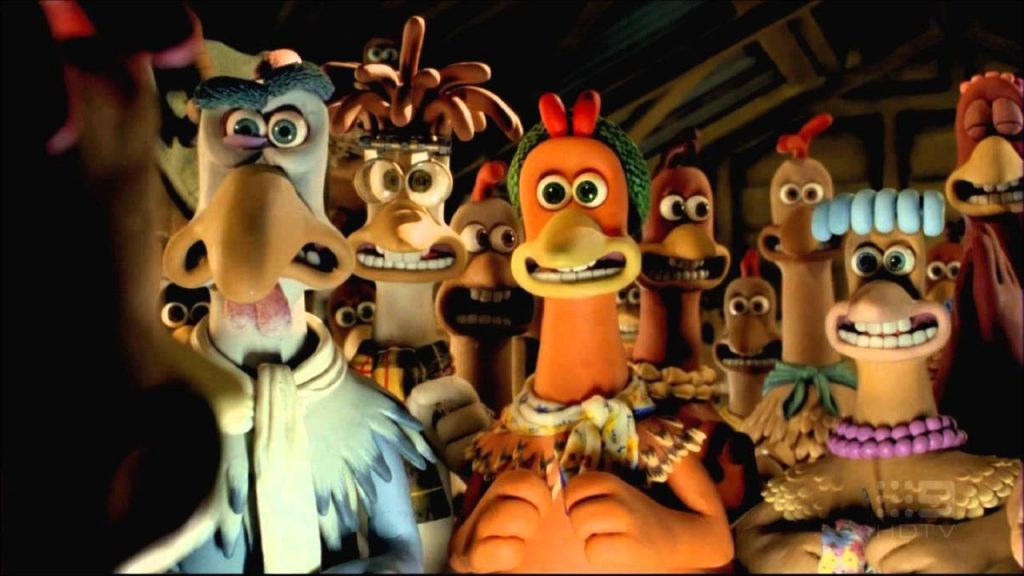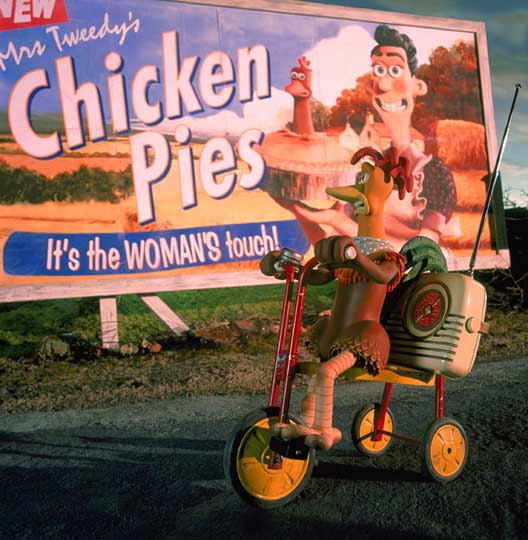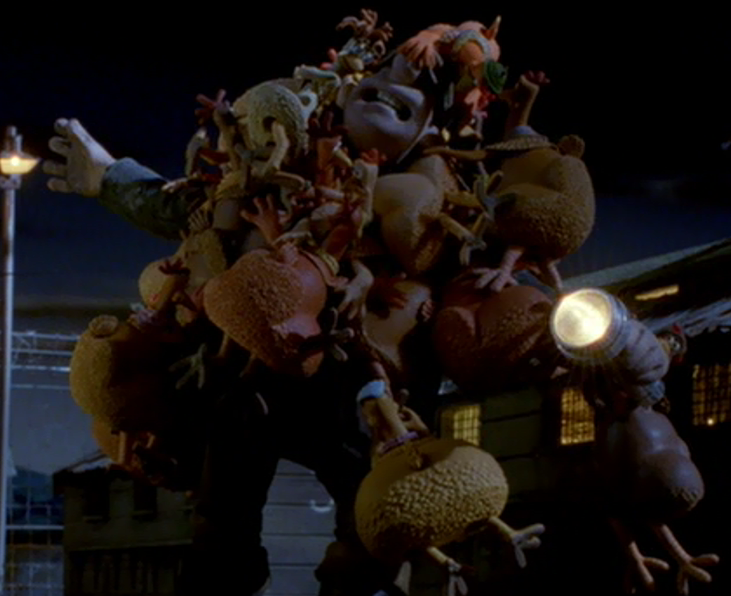
I must have first seen Aardman Animation’s Chicken Run (2000) around the age of seven, not long after its initial release, and I remember frequently quoting it after that. But the film’s self-consciousness about its family audience, manifested in the wonderful attention to detail, has meant that I have kept enjoying, noticing and learning new things as I watch it at an older age. It is a charming and comic stop-motion animation that depicts the bold adventures of hens on a chicken farm. Under the ruthless watch of the irascible Mrs Tweedy and her buffoonish husband, Ginger leads the chickens in their unrelenting attempts to escape from their imprisonment to the Yorkshire countryside. When Rocky, a Rhode Island Red rooster, inadvertently crash-lands on the farm, the hens set about learning to fly in the hope that they can flap their way to freedom. Exacerbated by the threat of Mrs Tweedy’s new chicken pie machine and the revelation that Rocky never really flew, their freedom becomes an increasingly vital but distant possibility. It is a witty and detailed comedy that subtly plays with the family audience’s differing perceptions of cinematic conventions, animal ethics and agriculture.
‘Have you been on holiday?’[i]
Chicken Run can be loosely defined as a family film, most notably for its jokes that differ in subtlety and sophistication, playing with the varying preconceptions of children and adults. There are absurd slapstick moments that appeal to younger viewers, such as the chickens’ attempts to fly, but also more intelligent jokes for the adults. For example, Edwina’s name is a reference to Edwina Currie, a minister who lost her job for claiming salmonella was rife in the British egg industry. This in-joke about “Eggwina” will most likely be lost on children and young adults (it certainly was on me). In addition, the film unashamedly pastiches prisoner-of-war films like The Great Escape (1963). Through the imagery of the hens’ huts and the barbed-wire fencing, Ginger’s solitary confinement and a triumphant, brass-band score, the film makes continual reference to these generic conventions to ironize the chickens’ imprisoned condition. By referencing through pastiche, the chickens are portrayed as heroic in their attempts to escape imprisonment. It is a running irony throughout the film that is fundamentally grounded in the chickens’ animality. Moreover, due to the painstaking process of Aardman’s signature “Claymation” format (see fig.1), the film is created with an exquisite attention to detail. In doing so, the audience is provided with another source of entertainment and wonder at the film’s creation which, in turn, draws attention to the film’s artifice. Paul Wells argues that animation’s ‘very aesthetic and illusionism enunciates difference and potentially prompts alternative ways of seeing and understanding what is being represented’.[ii]In the case of Chicken Run, we see this notion played out in its representations of gender and an anxiety about the treatment of animals within farming.
(fig.1)
‘The Woman’s Touch’
In making hens the focus of the narrative, the film becomes inherently female-dominated. Moreover, their daily existence, in which they live to lay eggs, is a fundamentally female one in a biological sense. The hens are presented as a collective community, displaying solidarity in the face of their adverse imprisonment. Most important of the hens and the film’s narrative is the character of Ginger. As the de facto leader of the hens, she is brave, determined, intelligent and intriguingly self-aware of the nature of their captivity. Her initiative and courage are presented early on through a montage in which she is repeatedly placed in solitary confinement after multiple escape attempts. Through the use of editing and mise-en-scene, the sequence introduces Ginger and the hens’ cyclical daily existence: the hens lay eggs, Ginger leaves solitary confinement, she shows the hens new escape plans, they carry these plans out in increasingly absurd manners, they fail, Ginger returns to solitary confinement and so on. After a few variations of this cycle, the sequence ends with four consecutive shots of Mr Tweedy slamming the bin that contains Ginger shut. In its entirety, the montage cinematically conveys Ginger’s unbreakable resilience, the mundanity of the hens’ egg-laying and Mr and Mrs Tweedy’s unforgiving treatment of the hens.

In comparison with the resilient female characters, neither Fowler nor Rocky, the only two male chickens, are presented as especially heroic. Rather, they are arrogant, pompous and, particularly in Rocky’s case, cowardly. The film ironically uses the characters’ animality to make jokes about gender relations, most notably through extensive punning. For example, it is no coincidence that Rocky is an extremely “cocky” character who is attracted to all the ‘beautiful English chicks’. Even the marketing punned on the film being a ‘chick flick’ about ‘a classy bird’. Further, Ginger’s relationship with Rocky is fraught and purely pragmatic for a large portion of the film: rather than swooning in adoration of Rocky like many of the other hens, Ginger only helps him to hide from the circus so he can teach them to fly and continually insists that he stops calling her ‘doll-face’. Through the use of the animated animal narrative then, Chicken Run consistently presents a dynamic subversion of cinematic representations of gender.
‘It’s all in me head!’
Despite her inspiring characteristics, Ginger is ultimately a chicken. But the film never forgets this and her triumphs and tribulations are all borne out of her animality. She is on this farm because she is a chicken and they fail to fly out the farm because chickens cannot fly. However, the film’s anthropomorphic representation of chickens provides them with a consciousness of their imprisoned condition. This is essentially what drives the narrative forward because, without this knowledge, they would not attempt to escape. Peter Lord, one of the co-directors, has expressed how the filmmakers ‘agonised over the question of whether chickens actually perceived themselves to be in prison or not’ (Wells, p.164). This anxiety about the representation of intelligent chickens is presented most notably when Ginger gives an inspirational speech. In honour of the recently executed Edwina, Ginger emphatically describes a utopian dream of freedom, paradise, no more egg counts and no more getting ‘plucked, stuffed, and roasted’. However, many of the hens fail to initially understand the possibility of such an existence. Ginger says that the real problem is that ‘the fences aren’t just around the farm, they’re up here, in your heads’. It is a surprisingly profound metaphor (particularly in its subtle nod to William Blake’s “mind forg’d manacles”) but it draws pertinent attention to the psychology of the chickens. Baffled by the concept of freedom, the hens ask, ‘Who feeds us?’ and ‘Where does the farmer live?’. The scene not only expresses Ginger’s heightened intellect over the other chickens but, through a tension between some chickens understanding and others not, it also self-referentially signals the film’s anthropomorphic representation of chickens. Further, Ginger’s utopian dream presents a surprisingly radical notion of an existence without systems of control or power and self-sufficiency through living with the natural world. Indeed, when they do finally escape, the ending presents their freedom through the imagery of a peaceful commune, surrounded by nature. Their new home is empty of industrial, mechanical and human-made machines that have constantly posed a threat to the chickens throughout the narrative.
‘I told you they was organised!’
Ultimately, it is the chickens’ awareness of their existential situation – their imprisonment – that makes Chicken Run’s representation of animals so intriguing. We would not conventionally consider it possible for a chicken to have such profound existential awareness because, for example, chickens do not continually make attempts to escape. For humans, it seems beyond the realms of possibility that a chicken could understand the concept of a different life, freedom, and a desire for it. This is, however a key characteristic of the animated format. As Paul Wells argues:
[It] is possible to view animation as an approach that inevitably facilitates a representational difference, and that intrinsically interrogates orthodox positions, embedded ideology, and epistemological certainty per se. Knowledge of and about apparently specific creatures […] is challenged and potentially redefined.
(Wells, p.5)
Not only does the animated format allow Chicken Run to challenge certain notions of gender relations, but also our preconceptions of a chicken’s intelligence more generally. In the case of Chicken Run, this challenging and redefining of knowledge is not necessarily a demonstration of the film taking a radical stance. Rather, it provides scope and possibility for self-referential humour, irony and wondrous entertainment. For example, due to his closer interaction with the chickens, Mr Tweedy becomes constantly paranoid that the chickens ‘are up to som’t’. Due to his general idiocy and a human preconception of a chicken’s intelligence, Mrs Tweedy disregards his fears without hesitation. This running gag is an ironic, self-referential gesture to the fictionality of the film – exemplified in the inherent illusionism of animation – as well as the animality of the chickens. The gag relies on the audience’s awareness of his paranoia being justified: firstly, because the chickens really are organised, and secondly, because we would not believe him either should we be in Mrs Tweedy’s position. Throughout Chicken Run, we see chickens continually bound by their animality but also possessing a heightened awareness of their existence, as well as self-referential jokes about the artificial nature of such characters.

Chicken Run is, in many ways, very similar to other Aardman works like Wallace and Gromit and Creature Comforts, not only for the distinctive style and format but through comic and frequently ironic depictions of intelligent animals and human-animal relations. Although much lighter in subject and tone, Chicken Run also bears similarities to Animal Farm due to the representation of animals rebelling against their existence on a farm. Both texts use anthropomorphic representations of animals to present narratives that contain an anti-industry, pro-animal critique to them. Finally, on a different note, I recommend Stewart Lee’s stand-up routine on satire in which, through a discussion of Planet of the Apes and Animal Farm, he ironically claims that ‘satire is when it’s the same as here but there’s animals’.[iii]
Bibliography
Burt, Jonathan, Animals in Film (London: Reaktion, 2009)
Chicken Run. Dir. Peter Lord and Nick Park. Pathe Distribution Ltd., 2000
‘Episode 3: Satire’, Stewart Lee’s Comedy Vehicle. BBC, 2014
Wells, Paul, The Animated Bestiary: Animals, Cartoons, and Culture (New Brunswick, New Jersey and London: Rutgers University Press, 2009)
[i] Chicken Run. Dir. Peter Lord and Nick Park. Pathe Distribution Ltd., 2000.
[ii] Paul Wells, The Animated Bestiary: Animals, Cartoons, and Culture (New Brunswick, New Jersey and London: Rutgers University Press, 2009), p.5.
[iii] ‘Episode 3: Satire’, Stewart Lee’s Comedy Vehicle. BBC, 2014.